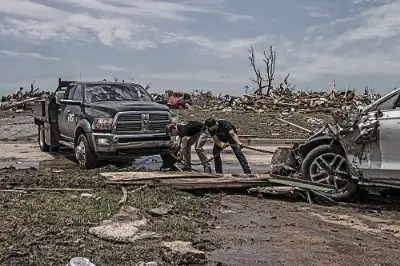Consumer Fraud Alert: Texas Flood Damaged Vehicles
 |
DALLAS -- June 11, 2015: It happened after Hurricane Katrina in 2005, the East Coast storms of 2006 and Super Storm Sandy in 2012.
After all those storms, flood damaged vehicles hit the used car market not long after. Many of them were not safe to drive.
GEICO advises consumers who are buying a used car or truck that they should first determine whether those vehicles were tagged by state officials as being flood damaged and if they are turning up on other databases of damaged cars.
GEICO works with state and local agencies and the National Insurance Crime Bureau (NICB) to tag severely damaged vehicles. VIN numbers of those cars and trucks are being entered into databases so consumers could check on the condition of any particular vehicle.
According to Ryan West, vice president of GEICO claims, “The damaged vehicles may look good, but it’s likely some of them have hidden problems and those problems could cost a lot.”
West adds that putting damaged cars on the market is an enormous safety concern and is essentially fraud.
Romano Thomas, local manager of special investigations in Texas, said, “SIU works to prevent fraud by checking flood claims against NICB and ISO databases to identify previous prior flood vehicles that require further investigation.”
GEICO recommends these steps for buyers before they close the sale.
Check VIN numbers at NICB site.
Information at the NICB site was compiled from state and local authorities, insurance companies and salvage yards.
Go to VinCheck and check to see if the car or truck you want to buy is in the database. You can check the vehicle identification number (VIN) number. The site is free to access at no charge as a service to the public.
Check with the Texas DMV.
Consumers can go to the Texas Department of Motor Vehicles and request a title history report on the vehicle they are considering buying. Texas may also provide a free online service for consumers to check VIN numbers of flood damaged vehicles.
Run a history report of a used vehicle.
Online services, available to the public for a small fee, can search nationwide databases and provide a detailed vehicle history report in seconds.
Things to look for related to flood damage:
- Check for mud, grit, rust or mold under the dashboard, throughout the entire engine compartment and the trunk. Use a flashlight and be thorough.
- Check the vehicle’s seats. There is a colored sealant around the screws that hold the seats in place. If the colored seal is broken, it could be a sign that the vehicle was involved in a flood because the seats may have been removed to replace or clean the carpeting.
- Look for rust and flaking on the vehicle’s undercarriage.
- Odors are a good giveaway. Take note if it smells musty or has been shampooed.
- Examine upholstery and carpeting. Be on the lookout for mismatched pieces and discolored or stained materials.
- Turn the car on and make sure all warning lights and gauges are working, particularly the airbag and ABS lights.
- Test the lights, wipers, turn signals, radio, heater and AC several times.
- Get a pre-purchase inspection from a professional before you close the deal.
Look carefully at the title:
- Be wary if the title is in an insurance company’s name or if it has brands like “flood,” “salvage,” or “rebuilt.”
- Proceed with great caution if the car history reveals it has been titled several times over a short period.
- Make sure there is a title.
- Check to see if the vehicle was last titled or registered in a flood-affected area.
Do not buy a vehicle at “curbside sales” on street corners. It will not be a bargain in the long run.


